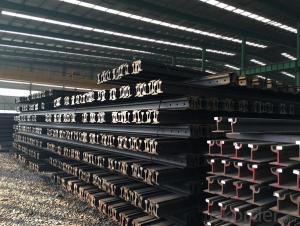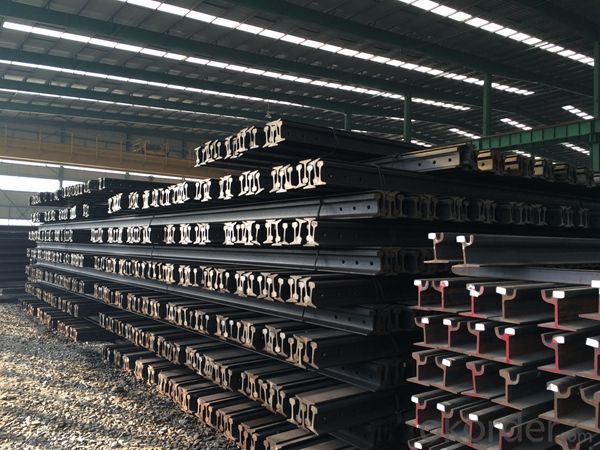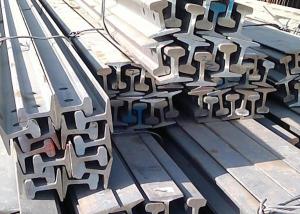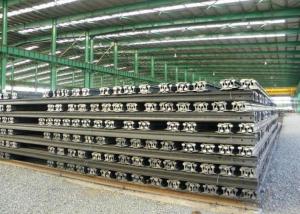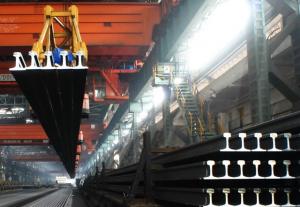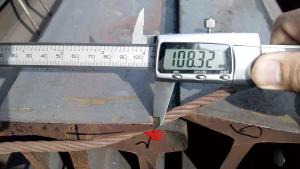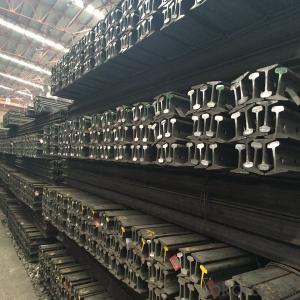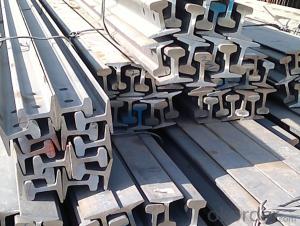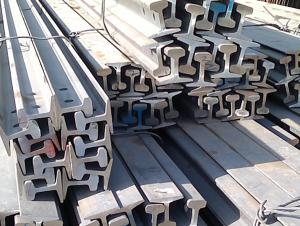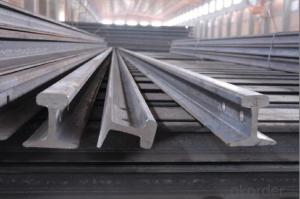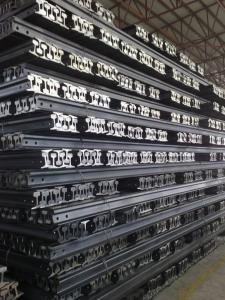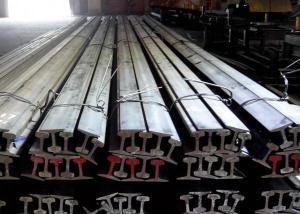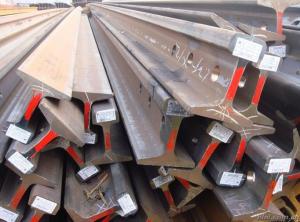Hot Rolled Light Steel Rail for Warehouse ,Minas, Structures
- Loading Port:
- Tianjin
- Payment Terms:
- TT or LC
- Min Order Qty:
- 25 m.t.
- Supply Capability:
- 2000000 m.t./month
OKorder Service Pledge
OKorder Financial Service
You Might Also Like
Specifications of Hot Rolled Light Steel Rail for Warehouse ,Minas, Structures
Product Name: High Quality Steel Rail
Production Standard: GB, AREMA, JIS, DIN, EN, UIC, BS, etc.
Grade: Q235B, 55Q, 900A, 1100A, 50MN, U71MN, R260.
Place of Origin: China
Length: 6M-24M according to the requriements of the customers.
Grade | Element(%) | ||||
C
| Mn | S
| P
| Si
| |
55Q
|
0.50—0.60 |
0.70—1.00 |
≤0.050 |
≤0.045
|
0.15-0.35
|
Applications of Hot Rolled Light Steel Rail for Warehouse ,Minas, Structures
Light rail is mainly used in forest region, mines, factories and construction sites laid of the place such as temporary transport line and light motorcycles with line.
Heavy rail is suitable for the laying of main trunk line of the curves and the orbit of the tunnel can also be used for tower crane and other crane track.
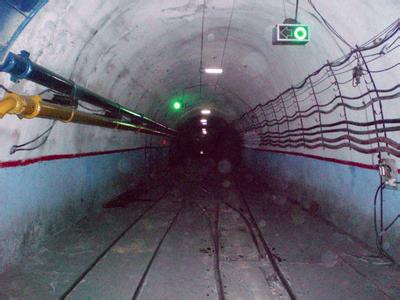
Packaging & Delivery of Hot Rolled Light Steel Rail for Warehouse ,Minas, Structures
1. Packing: it is nude packed in bundles by steel wire rod
2. Bundle weight: not more than 3.5MT for bulk vessel; less than 3 MT for container load
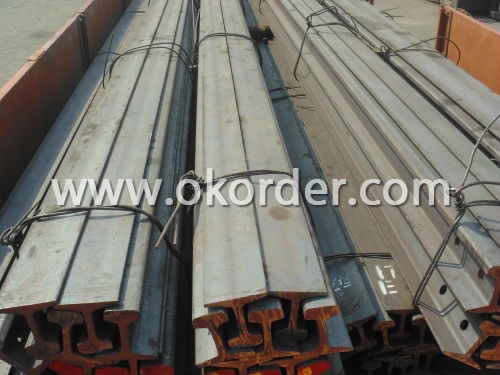
3. Marks:
Color marking: There will be color marking on both end of the bundle for the cargo delivered by bulk vessel. That makes it easily to distinguish at the destination port.
Tag mark: there will be tag mark tied up on the bundles. The information usually including supplier logo and name, product name, made in China, shipping marks and other information request by the customer.
If loading by container the marking is not needed, but we will prepare it as customer request.
4. Transportation: the goods are delivered by truck from mill to loading port, the maximum quantity can be loaded is around 40MTs by each truck. If the order quantity cannot reach the full truck loaded, the transportation cost per ton will be little higher than full load.
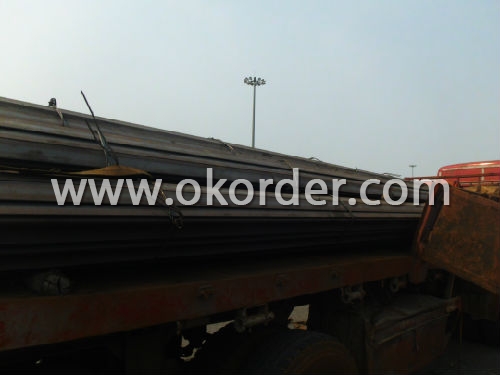
5. Delivered by container or bulk vessel
6. Delivery Time: All the Hot Rolled Steel Rail will be transpoted at the port of Tianjin, China within 30 days after receiving the advance payment by T/T or the orginal L/C at sight.
7. Invoicing on theoretical weight or actual weight as customer request
8. Payment terms: 30% advance payment by T/T, 70% payment against the copy of the B/L; 100% L/C at sight, etc.
Inspection of Hot Rolled Light Steel Rail for Warehouse ,Minas, Structures
We will send the MTC of the factory to the clients directly which contains the anlisis of the heat, chemiqual composition, phisical characteristicas, etc.
And our inspectors will arrive at the factory to meke the inspection of the size, length, weight and quantity before the transportation from the factory.
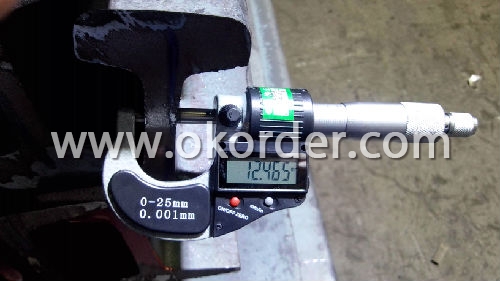
FAQ:
Q1: Why buy Materials & Equipment from OKorder.com?
A1: All products offered byOKorder.com are carefully selected from China's most reliable manufacturing enterprises. Through its ISO certifications, OKorder.com adheres to the highest standards and a commitment to supply chain safety and customer satisfaction.
Q3: What is the normal tolerance of Hot Rolled Mild Steel Angle Beams for Structures and for Buildings?
A3: Normally 3%-5%, but we can also produce the goods according to the customers' requests.
Q3: How soon can we receive the product after purchase?
A3: Within three days of placing an order, we will begin production. The specific shipping date is dependent upon international and government factors, but is typically 7 to 10 workdays.
- Q: What are the common issues faced by steel rails and how are they addressed?
- Common issues faced by steel rails include wear and tear, fatigue, corrosion, and misalignment. To address these issues, regular maintenance and inspections are conducted to identify and replace worn-out sections, repair cracks or fractures, and ensure proper alignment. Additionally, protective coatings and treatments are applied to prevent corrosion, extending the lifespan of the rails. Advanced technologies like ultrasonic testing and continuous monitoring systems are also used to detect potential problems and take prompt corrective actions, ensuring safe and efficient rail operations.
- Q: What are the different rail gauges used in steel rail systems?
- Rail systems around the world utilize multiple rail gauges, which refer to the distance between the inner sides of parallel rails on a railway track. Factors such as topography, historical development, and economic considerations primarily influence the selection of rail gauge. The standard gauge, with a distance of 1,435 millimeters (4 feet 8.5 inches) between rails, is the most commonly used gauge. It is employed in many countries, including the United States, Canada, Europe (excluding some narrow-gauge lines), China, Japan, Australia, and others. Aside from the standard gauge, different regions employ various other rail gauges, including: 1. Broad Gauge: This gauge has a wider distance between rails compared to the standard gauge. It is prevalent in India, Pakistan, and Bangladesh, with a gauge of 1,676 millimeters (5 feet 6 inches). Broad gauge offers greater stability and higher speeds, making it suitable for long-distance travel. 2. Narrow Gauge: This gauge has a smaller distance between rails than the standard gauge. It is commonly used in mountainous or remote areas with limited space. Narrow gauge railways are found in Switzerland, Mexico, South Africa, and parts of the United States. The gauge width varies, but most narrow gauge rails range from 762 millimeters (2 feet 6 inches) to 1,067 millimeters (3 feet 6 inches). 3. Meter Gauge: This gauge has a distance of 1,000 millimeters (3 feet 3.37 inches) between rails. It is predominantly used in Argentina, Brazil, and parts of Europe. Meter gauge is suitable for regions with moderate traffic levels and can be more cost-effective to construct and maintain compared to wider gauges. 4. Dual Gauge: In certain cases, a single track may accommodate two different rail gauges. These dual gauge systems enable trains of different gauges to share the same infrastructure. This approach is commonly used during transitions between rail networks or to ensure compatibility between neighboring countries. For instance, in Europe, dual gauge tracks facilitate seamless transportation across countries with different gauges at specific border crossings. These examples highlight the variety of rail gauges employed in steel rail systems worldwide. The selection of gauge for a specific railway network depends on various factors, including geography, historical development, and operational requirements.
- Q: How do steel rails contribute to train ride quality?
- Train ride quality is enhanced by steel rails in several ways. Firstly, the smooth and stable surface they provide allows the train to run smoothly. The design and manufacturing of steel rails guarantee their straightness and absence of deformities or irregularities. Consequently, the train wheels consistently make contact with the rails, resulting in reduced vibrations and a smoother ride. Moreover, steel rails possess remarkable strength and durability. They can withstand the heavy loads and constant impact of the train, maintaining their shape and integrity over time. This stability and strength contribute to a more comfortable and secure journey for passengers. In addition, steel rails play a vital role in maintaining the alignment and stability of the train. They are firmly fastened to the sleepers or ties, which are in turn fixed to the ground. This ensures that the tracks remain in place without shifting or moving during the train's motion. The stability of the tracks is crucial for a smooth and safe ride, as any misalignment or movement could cause discomfort for passengers. Furthermore, steel rails are specifically designed to reduce noise during train operations. The smooth surface and precise alignment of the rails minimize friction and noise generated as the train wheels roll over them. This contributes to a quieter and more enjoyable journey for passengers. In conclusion, steel rails are an indispensable element in enhancing train ride quality. They provide a smooth and stable surface, ensure alignment and stability, and reduce noise. As a result, passengers can experience a comfortable, secure, and enjoyable journey during train travel.
- Q: How are steel rails maintained in curved railway tracks?
- To ensure the proper functioning and safety of curved railway tracks, various methods are used to maintain the steel rails. Regular inspections are conducted by trained professionals to identify signs of wear and tear, damage, or deviations from the expected shape and alignment of the rails. These inspections involve visual examination and the use of specialized equipment to measure the geometry and detect defects. If any issues are found during the inspections, prompt maintenance measures are taken. This may include grinding the rails to remove surface irregularities and restore the desired profile. Grinding reduces friction between the train wheels and the rails, improving ride quality, reducing noise, and minimizing wear on both the wheels and rails. Aside from grinding, other maintenance activities involve adjusting the alignment and gauge of the rails. This ensures that the track remains within specified tolerances, preventing excessive wear and reducing the risk of derailments. The curvature of the rails is also carefully monitored to ensure it remains within the designed limits. To maintain the integrity of the rails, periodic ultrasonic testing is performed. This non-destructive testing method uses high-frequency sound waves to detect internal flaws, such as cracks or fractures, that may not be visible on the surface. If any defects are found, appropriate measures are taken to repair or replace the affected sections of the rail. Regular lubrication is another important maintenance practice for curved railway tracks. Lubricants, such as grease or oil, are applied to the rail surfaces to minimize friction and wear. This helps prolong the lifespan of the rails and reduce maintenance needs. In addition, vegetation control is crucial to prevent vegetation from obstructing the tracks and causing damage to the rails. Regular trimming and removal of vegetation are carried out to ensure clear visibility and prevent interference with the structural integrity of the rails. Overall, a combination of inspections, grinding, alignment adjustments, ultrasonic testing, lubrication, and vegetation control are employed as key maintenance practices to ensure the safe and efficient operation of steel rails in curved railway tracks. These measures help maintain the desired geometry, minimize wear, reduce friction, and enhance the overall performance and longevity of the tracks.
- Q: How are steel rails protected from chemical spills?
- Steel rails are typically protected from chemical spills through the application of protective coatings. These coatings act as a barrier, preventing the chemicals from directly contacting the steel surface and causing corrosion. Additionally, regular inspections and maintenance procedures are carried out to promptly identify and address any potential spills or leaks, ensuring the integrity of the steel rails.
- Q: What are the safety measures for workers handling steel rails?
- To ensure their well-being, workers must adhere to several important safety measures when dealing with steel rails. These measures comprise: 1. Personal Protective Equipment (PPE): It is crucial that workers don the appropriate PPE, which includes steel-toe boots, hard hats, gloves, and safety glasses. These items safeguard against potential injuries caused by falling objects, sharp edges, and flying debris. 2. Training and Education: Thorough training and education on safe handling techniques are imperative for workers. This should encompass proper lifting methods, understanding weight limits, and acquainting themselves with the specific hazards associated with steel rails. 3. Correct Lifting Techniques: Workers must receive training on the correct way to lift steel rails to prevent strains or back injuries. The utilization of mechanical lifting aids such as cranes, hoists, or forklifts can also diminish the risk of injury. 4. Secure Storage: Designated areas that are secure and stable should be used for storing steel rails. This prevents rolling or falling incidents that could lead to worker injuries. 5. Inspection and Maintenance: Regular inspection and maintenance of steel rails are vital to identify and address potential safety hazards. Any damaged or defective rails should be promptly removed from service and replaced. 6. Communication and Signage: Clear communication among workers is essential to prevent accidents. Signage should indicate areas where steel rails are being handled or stored, and any potential hazards should be clearly marked. 7. Safe Transport: Workers must ensure that steel rails are properly secured during transport to prevent shifting or falling. This involves using appropriate restraints and securing methods. 8. Emergency Preparedness: Workers should be aware of emergency procedures and have easy access to emergency contact information. They should also be trained in first aid and CPR to provide immediate assistance if necessary. By adhering to these safety measures, workers can significantly minimize the risk of accidents and injuries while handling steel rails. Employers must prioritize providing proper training, enforcing safety protocols, and regularly assessing and improving safety practices to protect their workers.
- Q: Are steel rails prone to deformation under load?
- Under normal load conditions, steel rails are typically resistant to deformation. Steel is renowned for its strength and durability, which makes it an excellent choice for constructing railway tracks. The design and manufacturing processes of steel rails prioritize their ability to withstand substantial loads and forces without deforming. However, it is important to acknowledge that abnormal or extreme load conditions, such as heavy locomotive traffic or excessive weight concentrated on a single point, have the potential to cause deformation in steel rails. In such instances, bending, warping, or even cracking may occur. To prevent these issues, rail tracks undergo regular inspections, maintenance, and replacement when necessary to ensure the efficient and safe functioning of the railway system. Moreover, temperature variations can also affect the behavior of steel rails. During hot weather, expansion can take place, while cold weather can lead to contraction. This thermal expansion and contraction can result in slight alterations in the shape of the rails. However, railway engineers and designers take these thermal effects into account by incorporating expansion joints and other measures to accommodate these changes and preserve the integrity of the tracks. In conclusion, while steel rails generally resist deformation under load, extreme load conditions or temperature variations can potentially cause deformation. Nevertheless, with proper maintenance and adherence to design specifications, steel rails can endure significant loads and offer a dependable and safe mode of transportation.
- Q: What is the average density of steel rails?
- The average density of steel rails is approximately 7,800 kilograms per cubic meter (kg/m³).
- Q: What is the role of steel rails in ensuring train stability?
- The presence of steel rails is vital for maintaining the stability of trains, as they serve as a solid foundation for the train to travel on. By evenly distributing the weight of the train, these rails help to maintain balance and prevent the train from derailing. One of the primary functions of steel rails is to guide the train and ensure that it stays on track. The rails have a specific design, featuring a flange on the inside of the railhead that fits into the groove of the train's wheels. This flanged wheel-rail interaction plays a crucial role in keeping the train aligned and preventing any deviations from the track. Moreover, steel rails provide a smooth and continuous surface for the train to move on. This smooth surface reduces the friction between the train's wheels and the rails, enabling the train to travel at high speeds with minimal resistance. Additionally, this smoothness minimizes vibrations and bumps, providing passengers with a comfortable ride. Aside from stability, steel rails also contribute to the overall safety of train operations. They are designed to withstand heavy loads and resist wear and tear. Regular maintenance and inspections ensure that any defects or damages to the rails are promptly identified and repaired, thus preventing accidents and ensuring the safe passage of trains. In summary, steel rails are indispensable for train stability as they guide the train, evenly distribute its weight, minimize friction, and provide a safe and smooth surface for the train to travel on. Without steel rails, trains would face challenges in maintaining stability and safety, making them an essential component of railway infrastructure.
- Q: How are steel rails protected from damage caused by hurricanes?
- Steel rails are protected from damage caused by hurricanes through a combination of proactive measures and post-hurricane assessments. To mitigate potential damage, railroads invest in robust maintenance and inspection programs. Regular inspections are conducted to identify any flaws or weaknesses in the rail infrastructure, including the steel rails. These inspections help detect issues such as corrosion, cracks, or uneven wear that could potentially worsen during a hurricane. In preparation for hurricanes, railroads also take preventive measures. They often undertake trimming and pruning of trees and vegetation along the railway lines to minimize the risk of falling debris. Additionally, railroads may reinforce vulnerable areas prone to flooding or erosion, such as installing retaining walls or reinforcing embankments. During a hurricane, railroads closely monitor the weather conditions and take necessary precautions. Trains may be rerouted or suspended to prevent accidents or damage to the tracks. Once the hurricane has passed, railroads promptly conduct post-hurricane assessments to evaluate the condition of the steel rails and other infrastructure elements. Any damage or hazards that are identified are swiftly repaired to restore the rail network's integrity and ensure safe operations. It is worth noting that steel rails are designed to withstand extreme weather conditions, including hurricanes. They are constructed to be durable and able to bear heavy loads. However, regular maintenance, inspections, and proactive measures are essential to minimize potential damage and ensure the safety and reliability of the rail system during and after a hurricane.
Send your message to us
Hot Rolled Light Steel Rail for Warehouse ,Minas, Structures
- Loading Port:
- Tianjin
- Payment Terms:
- TT or LC
- Min Order Qty:
- 25 m.t.
- Supply Capability:
- 2000000 m.t./month
OKorder Service Pledge
OKorder Financial Service
Similar products
Hot products
Hot Searches
Related keywords
